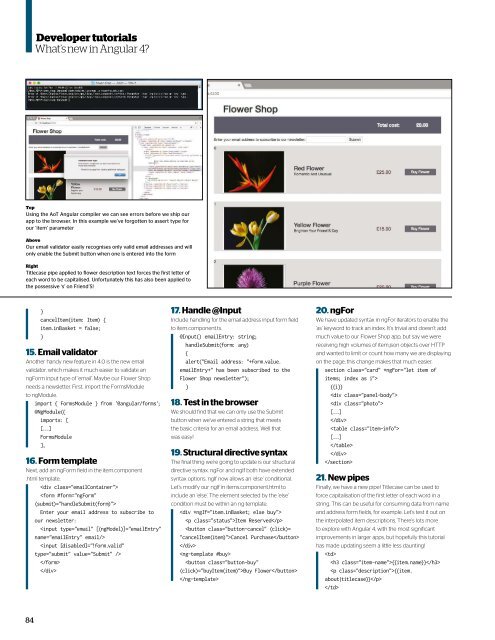Web_Designer_Issue_262_2017
You also want an ePaper? Increase the reach of your titles
YUMPU automatically turns print PDFs into web optimized ePapers that Google loves.
Developer tutorials<br />
What’s new in Angular 4?<br />
Top<br />
Using the AoT Angular compiler we can see errors before we ship our<br />
app to the browser. In this example we’ve forgotten to assert type for<br />
our ‘item’ parameter<br />
Above<br />
Our email validator easily recognises only valid email addresses and will<br />
only enable the Submit button when one is entered into the form<br />
Right<br />
Titlecase pipe applied to flower description text forces the first letter of<br />
each word to be capitalised. Unfortunately this has also been applied to<br />
the possessive ‘s’ on Friend’S!<br />
}<br />
cancelItem(item: Item) {<br />
item.inBasket = false;<br />
}<br />
15. Email validator<br />
Another handy new feature in 4.0 is the new email<br />
validator, which makes it much easier to validate an<br />
ngForm input type of ‘email’. Maybe our Flower Shop<br />
needs a newsletter. First, import the FormsModule<br />
to ngModule.<br />
import { FormsModule } from '@angular/forms';<br />
@NgModule({<br />
imports: [<br />
[...]<br />
FormsModule<br />
],<br />
16. Form template<br />
Next, add an ngForm field in the item.component<br />
.html template.<br />
<br />
<br />
Enter your email address to subscribe to<br />
our newsletter:<br />
<br />
<br />
<br />
<br />
17. Handle @Input<br />
Include handling for the email address input form field<br />
to item.component.ts.<br />
@Input() emailEntry: string;<br />
handleSubmit(form: any)<br />
{<br />
alert("Email address: "+form.value.<br />
emailEntry+" has been subscribed to the<br />
Flower Shop newsletter");<br />
}<br />
18. Test in the browser<br />
We should find that we can only use the Submit<br />
button when we’ve entered a string that meets<br />
the basic criteria for an email address. Well that<br />
was easy!<br />
19. Structural directive syntax<br />
The final thing we’re going to update is our structural<br />
directive syntax. ngFor and ngIf both have extended<br />
syntax options. ngIf now allows an ‘else’ conditional.<br />
Let’s modify our ngIf in items.component.html to<br />
include an ‘else’. The element selected by the ‘else’<br />
condition must be within an ng-template.<br />
<br />
Item Reserved<br />
Cancel Purchase<br />
<br />
<br />
Buy Flower<br />
<br />
20. ngFor<br />
We have updated syntax in ngFor iterators to enable the<br />
‘as’ keyword to track an index. It’s trivial and doesn’t add<br />
much value to our Flower Shop app, but say we were<br />
receiving high volumes of item.json objects over HTTP<br />
and wanted to limit or count how many we are displaying<br />
on the page, this change makes that much easier.<br />
section class="card" *ngFor="let item of<br />
items; index as i"><br />
{{i}}<br />
<br />
<br />
[...]<br />
<br />
<br />
[...]<br />
<br />
<br />
<br />
21. New pipes<br />
Finally, we have a new pipe! Titlecase can be used to<br />
force capitalisation of the first letter of each word in a<br />
string. This can be useful for consuming data from name<br />
and address form fields, for example. Let’s test it out on<br />
the interpolated item descriptions. There’s lots more<br />
to explore with Angular 4, with the most significant<br />
improvements in larger apps, but hopefully this tutorial<br />
has made updating seem a little less daunting!<br />
<br />
{{item.name}}<br />
{{item.<br />
about|titlecase}}<br />
<br />
84


















